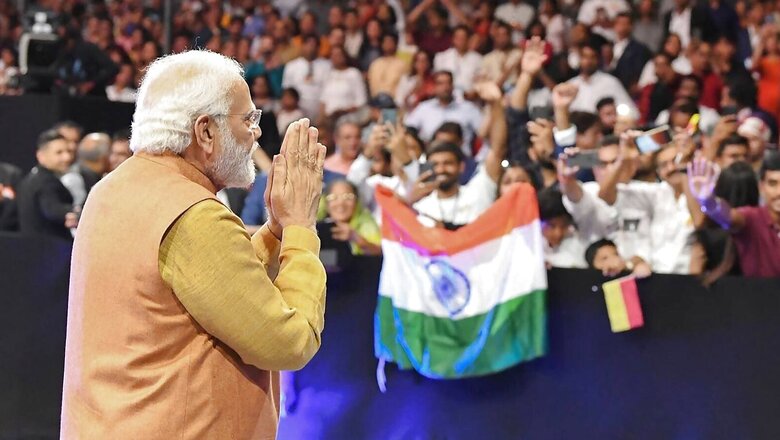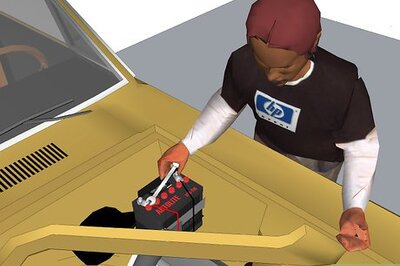
views
Right-of-centre political analysts like this columnist are often accused of glossing over the faults and failures of the Modi government. Not that one has reached the day of atonement, but for independent commentators, periodic hygiene checks are recommended to rule out blind spots and unconscious biases. With the euphoria of Independence Day and Amrit Kaal celebrations over, and the whiff of autumn in the air, it is a good time to sit down with some freshly brewed coffee.
In mid-2021, Modi’s approval ratings had taken a sharp beating in the aftermath of the Covid second wave — even though it was still way ahead of his challengers in the country and peers around the world. It was this time last year that his stock began to climb again as the impact of vaccination began to kick in and the economy also began to show its new green shoots. Defying sceptics and detractors, the Bharatiya Janata Party (BJP) sailed home in four of the five state assembly elections earlier this year.
Though there were macroeconomic concerns in the wake of the Ukraine-Russia war with rising oil prices, supply-chain disruptions, falling rupee vis-à-vis the dollar, and worries of inflation, India managed to keep its head above water and performed better than most large economies of the world. Attempts by the Opposition to cobble up a semblance of unity before the elections of the President and Vice President were brushed aside with Draupadi Murmu and Jagdeep Dhankhar breezing into office with resounding victories. Though these elections have no direct correlation with people’s mood, the outcomes do have a bearing on affecting public sentiments.
Thus, it came as no surprise to find in recent national surveys that the Prime Minister’s popularity remains undiminished. However, opinion polls do not always tell the full story. Statistics, as they say, often hide more than they reveal. So, are there undercurrents that observers are failing to detect or not picking up murmurs distracted by the surround sound of propaganda? One would think that Narendra Modi and Amit Shah with their exceptional political instincts and feedback mechanism will not ignore the cues from the ground. But even the sharpest of politicians have been blindsided and misled by pliant intelligence agencies. So, are there any red flags they are missing?
First, as always, is the subject of inflation that bugs all governments. When prices pinch pockets or hurt household budgets, statistics and global benchmarks are of little consolation. One tends to believe prices of items like petrol, diesel, and cooking gas primarily affect the urban middle class. However, the definition of middle class has changed over the years. Besides, thanks to television, travel, and an increase in general awareness, the aspiration levels of people at the bottom of the pyramid have undergone a major shift. So, rising prices of consumer goods make a difference even to the rural population who, having become used to branded products, are loath to downgrade.
Schemes like Ujjwala, which was a runaway success, can start biting once the number of subsidised and free cylinders is reduced. Many villagers are returning to wood fire. Diesel prices hurt agriculture, increasing the operation cost of tractors and pumps. Also, with more rural homes owning two-wheelers, the cost of commuting has gone up. To cushion the rural BPL (Below Poverty Line) segment, the central government had introduced the ambitious PM Garib Kalyan Yojana during the pandemic. Though extended till the end of September, the coverage has been pared down to target the weakest section of society. This is seen as a loss of benefit by those excluded now. All this makes the talk of “Revadi Economics” and reducing “freebies” problematic at this juncture.
In a country as populous as India, jobs are a perennial issue. In the absence of a national jobs database, there is no universally accepted methodology for tracking changes in unemployment levels and job creation. Active enrolment numbers in Employees’ Provident Fund leave the vast informal sector unaccounted for. So estimates vary widely between government sources and independent bodies monitoring the economy. Much reliance is placed on anecdotal evidence. However, going beyond numbers, there is also a qualitative issue.
Manish Sabharwal, the co-founder of staffing solutions firm Team Lease, had once made a controversial statement. He said that there was no dearth of jobs in India but the only problem is meeting the pay grade expectations of job seekers. To this, he added another dimension, namely that of the type of jobs.
This is becoming a serious issue in the post-Covid world where the nature of work is fast changing. Going forward with increasing automation, conventional jobs in factories, offices, and even in service sectors like Railways and airports are going to diminish. Instead, there will be a growing demand for skilled manpower, and opportunities will open up for small and micro-entrepreneurship. The challenge for the government would be how to harness the workforce and redirect them towards new horizons. Creating employment through “sarkari naukri” may not be either feasible or desirable.
The third chronic malaise afflicting India is the ubiquitous phenomenon of corruption. Arguably, there has been abatement in big-ticket corruption, especially at higher levels of government. However, at the grassroots, corruption is still a major problem even in BJP-ruled states. Raids and investigations by ED and CBI can deflect attention towards the rich and the mighty (as demonetisation did), but unless the problem of daily corruption in the lives of the ordinary citizen is alleviated it will not cut ice.
Finally, comes the sensitive issue of deepening religious fault lines. Apart from social costs, the economic impact of communal disharmony can be heavy — which will ultimately hurt the common man. In the short run, religious tension can disrupt the economy, causing financial hardships and demographic displacements. In the long term, it hurts investments. But unless controlled, this can turn into a monster with the potential of destabilising the country. There is enough evidence to indicate the infiltration of fundamentalist terror outfits in many states. These pose grave risks to internal security that outweigh even some of our external security concerns.
India is at the cusp of breaking into the big league of nations. Many inimical forces will try to derail the India story. A sure-shot way of doing it is by creating political instability — a model frequently used in other parts of the world. In their anxiety to dethrone Narendra Modi, some of our Opposition parties and leaders may be unwittingly co-opted by these anti-India elements. That will be the end of the India story. This is rightfully India’s century and we cannot let it slip out of our hands. Governments will come and go but we cannot allow the country to plunge into anarchy even for a short period. That is the biggest challenge for the Modi government in the near term.
The author is a current affairs commentator, marketer, blogger and leadership coach, who tweets at @SandipGhose. The views expressed in this article are those of the author and do not represent the stand of this publication.
Read all the Latest Opinion News and Breaking News here




















Comments
0 comment